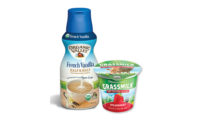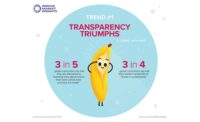Trends in Certified Food Label Claims
Fast growing non-GMO, organic, and fair trade trends create big opportunities

Skillful marketing helps processors break through barriers keeping consumers from recognizing and seeking out legally certified products.
SOURCE: FairTrade America/Tobias Thiele (www.fairtradeamerica.org)

SOURCE: iStock/Olivier Le Moal (www.istock.com)

Consumers have demonstrated that multiple label designations enhance point-of-purchase decision-making rather than confusion, as long as those badges resonate with their ideals.
SOURCE: Endangered Species Chocolate LLC (www.chocolatebar.com)

The first ingredients and products to stress the importance of fair trade practices chocolate, bananas, coffee, vanilla, and tea are sourced from countries most vulnerable to exploitation.
SOURCE: FairTrade America/Mirjam Groten (www.fairtradeamerica.org)

Cereal makers adapted to the non-GMO shift with relative speed, bringing a comprehensive offering of the top brands into the GMO-free fold in short order.
SOURCE: Post Foods LLC. (www.postfoods.com)







Foods labeled “Non-GMO,” “Organic,” and “Fair Trade,” once found only in natural food stores, are proliferating in mainstream supermarkets. Consumers want foods made with fewer, more simple, and natural ingredients—and without genetically modified organisms, pesticides, and difficult-to-pronounce ingredients.
Products with third-party certified labeling claims continue to see strong consumer demand. However, certification requires commitment and documented traceability, while ingredient sourcing can involve long-term planning to ensure steady and consistent supplies. Sourcing challenges for ingredients that are organic, natural, sustainable, fair trade, GMO-free, etc., are being addressed by suppliers with unprecedented speed. 
Market data confirm the rise of non-GMO, organic, and other certification trends. Mintel’s Global New Product Database (GNPD) finds that 15.7% of new products introduced in 2015 made “Non-GMO” or “GMO-free” claims—an increase from 10.7% in 2014 and 2.8% in 2012. This makes non-GMO the fastest growing food label claim. Similar strong growth is seen in organic products, with 13.5% of new products making organic claims in 2015, up from 10.7% in 2014. New products with ethical claims, such as fair trade, also are increasing, although a little more slowly; 7.9% of new products featured such ethical claims in 2015 compared with 6.7% in 2014.
Non-GMO Mainstream
Foods with non-GMO claims are now common, found on major food brands. These include General Mills Inc.’ Cheerios cereal, Post Holdings, Inc.’s Grape Nuts cereal, Unilever N.V.’s Ben & Jerry’s brand ice cream and Hellmann’s brand mayonnaise, The Hershey Co.’s chocolate syrup, Del Monte Foods Inc.’s full line of canned vegetables, J. M. Smucker Co.’s Smucker’s brand of natural jams, and even Abbott Laboratories’ Similac infant formula. And the list continues to grow.
According to a 2015 Market Research Group LLC’s Packaged Facts consumer survey, 39% of respondents reported actively buying grocery products with “GMO-free” on the labels.
Ingredient suppliers confirm strong demand for non-GMO ingredients. What once was associated with grains and produce has extended to encompass the widest swath of larger companies and brands.
The aforementioned Ben & Jerry’s transitioned to non-GMO ingredients in its ice creams from 2012- 2014. Most of the company’s core ingredients had no GMO risk. But a big exception was the frozen novelty maker’s inclusions portfolio—the candies, nuts, baked goods, and other items incorporated into the ice creams. But some of the core ingredients were affected.
Both Ben & Jerry’s and its suppliers had to switch from using GMO-risk maltodextrin, soy lecithin, corn syrup, and starches to non-GMO alternatives. Even the sweeteners used in cherries for the company’s big-selling Cherry Garcia ice cream were switched from GMO beet sugar to cane sugar. Heath Bar inclusions containing GMO ingredients were replaced by non-GMO, butter toffee crunch bars. For Ben & Jerry’s, switching to non-GMO ingredients aligned with the company’s social mission values. “It’s about ‘walking our talk’ through supporting small family farms and sustainable agriculture,” says Cheryl Pinto, the company’s global values-led sourcing manager. “It re-emphasizes that we act on our values.”
According to Pinto, it is becoming easier for companies to switch to non-GMO ingredients. “As more and more big companies offer non-GMO products, the availability of non-GMO ingredients is increasing,” she acknowledges.
To increase the supply of non-GMO grains and ingredients, Ben & Jerry’s teamed up with the non-profit cooperative Green America to create a Non-GMO Working Group. The group comprises members from the length of the supply chain, from seed producers and farmers to large food manufacturers and retailers.
Proof Positive
An increasing number of ingredient suppliers are having their products Non-GMO Project-verified, which also makes it easier for food companies to become verified. However, adequate supplies of ingredients also depend on the types of those ingredients. Sourcing high-risk ingredients, such as corn and soy, is the most challenging. (It should be noted that, although GMO wheat is in development, it is not commercially available in the US.)
Today’s farmers are availing themselves of increased education and awareness opportunities about what’s needed to produce non-GMO products, although ingredient experts recognize that grain handling infrastructure remains to be fully developed in some areas.
Increasingly, non-GMO and organic ingredient suppliers are having their products third-party verified by the Non-GMO Project. The verification procedure is rigorous and necessarily must be comprehensive, especially in light of some slip-ups in the early years. The process involves audits, traceability, documentation, and, of course, thorough testing of all ingredients.
Unlike organic certification, which has a national, uniform standard for qualification, non-GMO still has no such national standard. The Non-GMO Project, which launched in 2007, has emerged as the leading non-GMO standard, as evidenced by the 35,000 products that the Project has verified. With the rapid growth of the non-GMO market, other non-GMO certification programs have emerged. The two most notable competing programs are NSF International’s Non-GMO True North certification and the USDA’s Process Verified Program.
Organic Challenges
As with non-GMO, the organic market is experiencing phenomenal growth, with sales of organic products now above $40 billion annually. Large companies are increasing organic offerings, as well as snapping up small and medium organic brands, such as General Mills did in 2014, with Annie’s Homegrown Inc., for a reported sum of $820 million.
Ingredient suppliers have noted that many non-GMO ingredient seekers also demand the ingredients be organic. And, while organic ingredients by certification cannot be GMO, the opposite is still possible. The combination of the two qualifications, coupled with the demand stress created when large food manufacturers get on board with these programs, periodically has caused supply-demand strain. This is especially difficult for ingredients such as soy and corn that, until very recently, were about 80-90% GMO sourced in the US, unlike in the rest of the world.
Luckily, enough ingredient growers and suppliers recognized the coming tide and began planning for the dramatic increase, removing some of that strain. Still, challenges can occur. For example, one supplier pointed to a shortage of organic yeast just a few years ago, but noted how at least four companies stepped into the void to provide a more reliable supply of organic yeast.
To address the shortages, organic food companies have launched initiatives to increase organic acres. A collaboration among leading organic food companies, including Annie’s, Clif Bar & Co., Stonyfield Farm Inc., the Organic Valley cooperative, Whole Foods Market Inc., and others launched last year to increase acres of organic grains, pulses, and oil seeds.
Careful scrutiny still is in order, as consumers still express confusion over what the specifics of an organic label on a product actually means. According to a 2014 study published in the International Food and Agribusiness Management Review, 17% of US and Canadian consumers think organic food is also locally grown, while another 23% believe locally grown food is automatically organic.
“Despite organic sales and accessibility at all-time highs, consumer confusion about organic benefits remains significant,” noted Laura Batcha, CEO of the Organic Trade Association, via Danielle Nierenberg’s Food Tank non-profit think tank. “Consumers need to know the facts about organic, so they can make the smartest choices for themselves and their families.”
Worth the Wait
Supply shortages still crop up, especially for those ingredients in the organic market that take longer to establish supplies for—such as grains and produce. Organic food accounts for about 5% of all food sales in the US, but organic farming acres total less than 1% of US farmland. These items require three years of crop rotations before produce from the land they’re grown on can be considered organic. And some fields can never qualify.
The Organic Trade Association is working with the USDA to create a Certified Transition label program that will help farmers market their crops during the three-year transition to organic, since this is one of the biggest challenges to increasing organic farming.
The key to sourcing organic ingredients, as in the non-GMO supply chain, is long-term planning, particularly for bigger companies that need greater quantities of ingredients. A company wishing to make the switch to organic must take long-range thinking and long-term contracts into account. In this manner, it can pay to work in tandem with suppliers and growers.
One example is Clif Bar, which makes organic nutrition bars. One of Clif Bar’s main organic ingredients is figs. Faced with a supply shortage a few years ago, Clif Bar approached its main fig supplier and proposed a seven-year contract to encourage a transition to 300 more organic acres. Clif Bar guaranteed the purchase of all the figs grown on the 300 acres during the three-year transition—and for four more years when the figs were certified organic.
The grower happily accepted the proposal, as it would make up all the transition costs in the first four years after going organic. Other large food companies, including Chipotle Mexican Grill Inc. and the huge Hain Celestial Group, are offering farmers similar long-term contracts to secure organic supply.
All’s Fair
Fair trade certification is another growing trend among food manufacturers. Fair trade standards focus on social, economic, environmental, and sustainability factors. These include safe working conditions; no forced or child labor; elimination or reduction of harmful chemicals and pesticides; and no GMOs.
“Fair trade encompasses not only the health and sustainability of the environment, but also the health of people working in that environment,” says Jenna Larson, a senior manager at Fair Trade USA, the leading third-party certifier of fair trade products in the US.
Fair Trade USA certifies products from 30 different categories, including coffee, tea, cocoa, sugar, fruits and vegetables, beans and grains, spices, nuts, and seafood. Coffee accounts for one half of the fair trade-certification volume. About 1,000 US companies offer fair trade-certified products.
Fair Trade USA works with food manufacturers to help them locate sources for certified ingredients, which include cocoa, sugar, coconut, spices, vanilla, agave, and sweeteners. And more certified ingredients are becoming available, according to Larson. “We work with brand companies to find the right quantity, quality, and flavor profile to meet the needs of their formulations,” she says. “There are more opportunities to integrate sustainability into recipes and packaged foods.” Larson adds that fair trade certification strengthens and increases transparency in supply chains and invests in the long-term sustainability of producing farmers and communities. “It also is a way of communicating a company’s sustainability story to customers,” she says.
Along with fair trade, there are a number of sustainability certification programs for farming and food production. These include Rain Forest Alliance, Food Alliance, and SCS Global Services’ “Sustainably Grown” certification. These programs have standards that address sustainability, environmental and social responsibility, and economic stability.
Critics say that such certification programs are “organic lite” and not as rigorous as organic standards, and their eco labels create more confusion for consumers already inundated with labeling claims. Others say that sustainable certification provides farmers a viable middle option between conventional and organic farming. However, consumers continue to show strong acceptance for anything that indicates greater-than-average care has gone into selecting the ingredients that appear in foods and beverages.
Growing Trends
Food and beverage manufacturers are considering organic and non-GMO-verified sweetener options to replace GMO-risk beet sugar and high-fructose corn syrup in their products. These alternatives include agave, stevia, honey, cane sugar, rice and tapioca syrups, and erythritol, among others. Tapioca syrup, especially, is enjoying closer looks by manufacturers, due to the ease of substitution it allows processors in formulations.
Demand for alternative sweeteners and oils also is driven by the industry trend toward clean labels with simpler, fewer, and non-GMO ingredients. Ingredients made from sunflowers, such as oil and lecithin, are becoming popular, because they are non-GMO and perceived as healthier options.
“Food manufacturers are adding sunflower oil, because it has an exceptional fat profile with less than 10% unhealthy saturated fat, no trans fat, and over 90% healthy unsaturated fat,” says John Sandbakken, executive director of the National Sunflower Association.
Other suppliers see strong demand for pea and other vegetable-based proteins. Such vegetable-derived protein is becoming more popular due to multiple qualities, from not only the organic and non-GMO standpoints, but also the reduced risk of allergens and the gluten-free aspects. Moreover, pea proteins carry a sustainability advantage, because peas are a good rotational crop for farmers and add nitrogen to the soil.
Ingredients from seeds, such as chia, hemp, and flax, as well as from more envelope-pushing sources like fungi, algae, duckweed, and similar new sources, are growing fast for the same cluster of advantages.
The combination of sustainability, ease of non-GMO certification, and low carbon footprint these healthful ingredients carry is taking them from the fringe to the mainstream much more quickly than traditionally occurred when a new ingredient came on the scene.
While it might seem that every product these days carries some sort of marketing claim, certifiable ingredients, and thus the products made from them, are unlikely to fade in popularity. For formulators, the marketing challenge is becoming minimal, as such products effectively sell themselves. The challenges of sourcing still are out there, but the energy from suppliers is bearing fruit, as shortages become fewer and farther between.
Organic and Non-GMO Report
From obscure grain industry terms to household words, organic and non-GMO are now the most popular label claims on the food scene. Market data confirm the non-GMO market's growth as the fastest growing food labeling claim in the US, with annual growth of 50% per year- even faster than gluten-free, fair trade, and other categories. According to the Natural Marketing Institute, 59% of consumers are using non-GMO products. The Non-GMO Project, the leading non-GMO verification organization, already has verified nearly 35,000 products that produce a combined $16 billion in annual sales.
The Organic & Non-GMO Report currently is the only publication tracking this fast growing market, along with the equally strong market for organic foods. Now in its 16th year of publication, the report is designed to help food manufacturers locate sources for non-GMO grains and ingredients and keep the up-to-date on issues, such as GMO labeling, non-GMO certification and testing, and other topics that impact their businesses.
The Non-GMO Project also provides the world's only "farm to fork" directory of non-GM products in its Non-GMO Sourcebook. Published annually, the sourcebook features more than 800 suppliers of non-GMO products, including seeds, grains, ingredients, animal feed, and food products.
For more information about The Organic & Non-GMO Report, visit www.non-gmoreport.com.
Originally appeared in the June, 2016 issue of Prepared Foods as Certified!.
Ken Roseboro is editor and publisher of The Organic & Non-GMO Report, the leading publication focusing on the fast growing markets for non-GMO and organic foods, (www.non-gmoreport.com). Roseboro also is the editor and publisher of The Non-GMO Sourcebook, the world’s only “farm to fork” directory of suppliers of non-GMO seeds, grains, ingredients, animal feed, and food products www.nongmosourcebook.com).Roseboro’s articles have appeared in leading food and agriculture publications and websites, including Civil Eats, New Hope 360, Organic Connections, World Grain, Natural Foods Merchandiser, the pages of Prepared Foods, and other journals. He is on the board of directors of the Iowa Organic Association and a founding member of the Non-GMO Supply Working Group (www.centerforsustainabilitysolutions.org/non-gmo-supply-working-group).
Looking for a reprint of this article?
From high-res PDFs to custom plaques, order your copy today!












